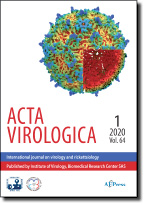Acta Virologica Vol.65, No.1, p.49-57, 2021
|
| Title: Differential in vitro effect of endogenous and exogenous nitric oxide on replication of the persistent respiratory syncytial virus genome |
| Author: Kenya Maldonado-Pérez, Beatriz Gómez, Carlos Santiago-Olivares, Evelyn Rivera-Toledo |
|
Abstract: Synthesis of nitric oxide (NO) is induced as an early response to viral challenges. Here, we studied effects of endogenous and exogenous NO on respiratory syncytial virus (RSV) genome replication, using a persistently RSV infected macrophage-like cell line. NO was evaluated indirectly by nitrites accumulation and it was increased in infected macrophages with respect to non-infected cells. Phagocytosis of bacteria by persistently RSV infected macrophages increased nitrites production, and under such conditions the number of RSV-genome copies decreased up to 8.7-fold, whereas chemical inhibition of the inducible-NO synthase enzyme increased viral replication 2.7-fold. Since phagocytosis activates many signaling pathways, which could contribute to viral control, we explored the individual effect of NO by using the NO donor SNAP. Intriguingly, even though SNAP raised nitrites levels up to 3-fold, the number of RSV genome copies augmented 2.3-fold. This enhancement was associated with lengthening of the G0/G1 cell cycle phase mediated by the NO donor, as evaluated by BrdU/7-AAD incorporation through flow cytometry; this phase of the cell cycle was favorable for an increased RSV genome replication. Thus, NO produced endogenously during RSV persistence was not enough to control virus replication, although macrophage activation through phagocytosis inhibited replication of the persistent viral genome. In contrast, the NO donor SNAP increased viral genome replication, at least partially by altering the cell cycle, indicating that both sources of NO were not bioequivalent.
|
|
| Keywords: cell cycle; endogenous nitric oxide; exogenous nitric oxide; nitric oxide donor; respiratory syncytial virus; viral persistence |
|
|
Published online: 01-Feb-2021
|
| Year: 2021, Volume: 65, Issue: 1 |
Page From: 49, Page To: 57 |
doi:10.4149/av_2021_105
|
|
 download file download file |
|
|
|
|
 download file
download file
